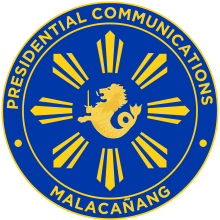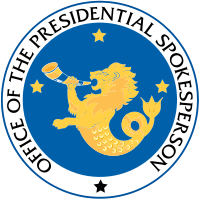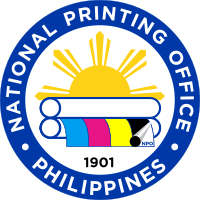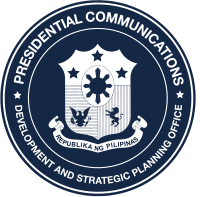Presidential Communications Group
This article includes a list of general references, but it remains largely unverified because it lacks sufficient corresponding inline citations. (September 2017) |
 Seal | |
| Agency overview | |
|---|---|
| Formed | July 30, 2010[1][2] |
| Headquarters | 2nd Flr. New Executive Bldg., Malacañang Compound, Manila |
| Annual budget | ₱1.69 billion (2020)[3] |
| Agency executives |
|
| Website | www |
The Presidential Communications Group, or simply the Communications Group, is the collective name for the offices within the Office of the President of the Philippines[a] and refers to the following positions and offices: the Presidential Spokesperson and the Presidential Communications Operations Office (PCOO)—formerly known the Office of the Press Secretary.
The Communications Group is primarily responsible for planning, programming, and coordinating the activities that will most effectively collect information about what is happening in the Executive branch of the government, and getting this information to the media. The Group's other role is to help Filipinos understand government policies and programs, and to shore up support for them.
Presidential Spokesperson[]

The Presidential Spokesperson speaks on behalf of the President about matters of public interest. Considering the restricted level of access that the media has to the Chief Executive, the Spokesperson is expected to be the primary source of presidential directives in the absence of the President of the Philippines.
The Presidential Spokesperson is not subject to confirmation by the Commission on Appointments, and does not have any specific item or template in government.
The current Presidential Spokesperson is presently vacant due to the resignation of Harry Roque, while the Assistant to the Presidential Spokesperson is Atty. Kris Roman of the Duterte administration.
Presidential Communications Operations Office[]
The Presidential Communications Operations Office (PCOO) is in charge of disseminating the government’s message to private media entities. It exercises supervision and control over state-owned media entities to disseminate the official messages properly and effectively in accordance with the communications plan. It is responsible for the accreditation and authentication of the credentials of foreign media correspondents in line with its primary task to cultivate relations and assist private media entities.[1] During the administration of Benigno Aquino III, the Office of the Press Secretary (OPS) was named the Presidential Communications Operations Office (PCOO).
The PCOO head holds a cabinet rank. He/she is assisted by an undersecretary for administration and finance, an undersecretary for operations, a chief of staff, an assistant secretary for legislative affairs, and an electronic data processing division chief.[4]
The PCOO is composed of the following units and agencies:
- News and Information Bureau
- Philippines News Agency
- Philippine Information Agency
- Intercontinental Broadcasting Corporation
- Radio Philippines Network
- People's Television Network
- Philippine Broadcasting Service - Bureau of Broadcast Services (Radyo Pilipinas)
- Presidential Broadcast Staff-Radio Television Malacañang (referred to as PBS-RTVM or simply RTVM)
- Bureau of Communications Services
- National Printing Office (NPO)
- APO Production Unit
- OP Web Development Office (commonly referred to as the President's New Media Team)
Units under the Presidential Communications Operations Office[]
Presidential News Desk[]
The Presidential News Desk (PND) functions as the newsroom of Malacañang Palace. It gathers and disseminates information, such as press and photograph releases, and official statements from the Palace, on a daily basis.
The PND operates from Sundays to Saturdays, 5:00 AM to 7:00 PM. It is headed by a chief editor and is composed of a managing editor, deskmen, and reporters. Other units, which support the PND are Electronic Data Processing, Transcription and Monitoring, and Photographs.
Francisco Tatad conceived the PND. He was the Press Secretary to President Ferdinand Marcos. It was then called the Central Desk and was located in the Mabini Building. During the administration of President Corazon C. Aquino, Press Secretary Benigno Teodoro relegated the Central Desk, which became the News and Reportorial Section, as a section of the Presidential Press Staff. Under the Ramos administration, Press Secretary Rodolfo Reyes strengthened presidential coverage and set up the PND.
Philippine Information Agency[]

The Philippine Information Agency (PIA), established by Executive Order No. 100,[5] is the main development communication arm of the government. It is under the Presidential Communications Operations Office (PCOO).
The PIA directly serves the Presidency and the executive branch of the national, regional and provincial levels through its 16 regional offices and 71 provincial information centers.
Its core services include: information gathering/research, production and dissemination, and institutional development and capacity-building focusing on alliance-building, networking, communication-related training, consultancy and technical assistance. The PIA is also the advertising arm of the government.
It is headed by a director general and a deputy director general, staff directors in the central office, regional directors in the regional offices, and more than 500 permanent and contractual employees. It works closely with other government agencies, in particular the National Printing Office in the production of information materials.
Its tagline is "Empowering Communities". The PIA works with community stakeholders, including local government units, line agencies, private entities, schools, colleges and universities, civil society organizations, and other groups in ensuring proper dissemination of information at the grassroots level. The agency advocates responsible sharing of information and responsible use of social media. Its current management and personnel work with the mantra and belief that "a well-informed Filipino is an empowered Filipino".
In 2017, the PIA was tasked by PCOO to take the lead in promoting the 31st Association of Southeast Asian Nations Summit and established information kiosks in more than 90 locations in the country and conducted community fora and dialogue with community leaders and local townsfolk.
Bureau of Communications Services[]
The Bureau of Communications Services is the attached agency of the PCOO that is tasked to provide materials and services related to various functions of the Presidency, PCOO and the general public. It also owns Balita Central, a tabloid newspaper which is published bi-monthly through its official website and at selected LRT Line 2 stations.
It also produces information materials for state events such as the anniversary of the People Power Revolution, Araw ng Kalayaan celebrations, and others.
Director IV Ma. Florinda Princess E. Duque is the bureau's current director.
Presidential Broadcast Staff - Radio Television Malacañang[]

Created by President Corazon C. Aquino under Executive Order No. 297 on July 25, 1987,[6] the Presidential Broadcast Staff - Radio Television Malacañang is tasked to provide the necessary media services, video and audio, to the incumbent President, to document all official engagements, and to make available to the public accurate and relevant information on the activities, programs and pronouncements of the national leadership.
The agency is involved in television coverage and documentation, news and public affairs syndication of all the activities of the President, either live or delayed telecast through government or private collaborating networks.
Media networks[]
There are three government-run television networks, namely the People's Television Network (PTV-4), the Radio Philippines Network (RPN-9) and the Intercontinental Broadcasting Corporation (IBC-13). The Philippine Broadcasting Service (PBS) constitutes the government radio network.
IBC-13 and RPN-9 were sequestered by the government after the fall of the Marcos dictatorship. However, plans are being made to privatize IBC-13 and RPN-9 within two years to raise money. According to the 2009 report of the Presidential Commission on Good Government (PCGG), IBC-13 is valued at PHP 3.074 billion while RPN-9 is valued at PHP 1.3 billion.[7][8]
National Printing Office[]

The National Printing Office (NPO) was established by Executive Order No. 285 on July 25, 1987.[9] Executive Order No. 285 abolished the General Services Administration and transferred its functions to other agencies. Its Government Printing Offices were merged with the printing units of the PIA. The NPO is mandated by Executive Order No. 285 to print forms, official ballots, public documents, and public information materials.[10]
News and Information Bureau[]
The News and Information Bureau's main aim is to provide services relating to the development and formulation of a domestic and foreign information program for the Government in general, and the Presidency in particular, including the development of strategies for the dissemination of information on specific government programs. It is composed of the following divisions:
- Finance and Administrative Division
- Presidential Press Staff
- Media Accreditation and Relations Division/International Press Center
- Philippine News Agency
OP Web Development Office[]
The OP Web Development Office, commonly referred to as the President's New Media Team, is responsible for the establishment and management of the President's Official Website and Official Presence on social networking channels such as Facebook, Twitter, and YouTube. It is also partly responsible for the feedback mechanism of the President wherein it receives the comments, concerns and suggestions through the Contact Us section of the President's website. It is also responsible for the President's Social Media engagement and in maximizing the use of new technologies to further the President's agenda, policies and programs.
Presidential Communications Development and Strategic Planning Office[]

The Presidential Communications Development and Strategic Planning Office (PCDSPO) ensures that all aspects of communications are covered, to ensure that the administration’s message has been delivered successfully. This includes market research and polling. It devises the communications strategy to promote the President’s agenda throughout all media, and among the many people with whom the administration interacts. This can include, but is not limited to, the State of the Nation address, televised press conferences, statements to the press, and radio addresses. This office also works closely with cabinet-level departments and other executive agencies, in order to create a coherent strategy through which the president’s message can be disseminated.[1]
During the administration of former president Benigno Aquino III, the PCDSPO head held a cabinet rank. The head was supported by a deputy of undersecretary rank, a chief of staff, an assistant secretary for messaging, and an electronic data processing division chief.[4] After Rodrigo Duterte became the President in 2016, the PCDSPO was merged with the PCOO, thus effectively abolishing the PCDSPO. The PCOO was renamed as the Presidential Communications Office before it was reverted to Presidential Communications Operations Office.[11]
Prior to June 30, 2016, the PCDSPO was composed of the following units and agencies, all of which were under the PCOO:
- Presidential Message Staff
- The OP Correspondence Office (previously placed under the Office of the Communications Director from the Presidential Management Staff per E.O. No. 348, 11 August 2004[12]
- Media Research and Development Staff created by E.O. No. 297, 25 July 1987,[6] from the Office of the Press Secretary
- The Presidential Museum and Library
- The Official Gazette
- The Speech Writers Group (previously placed under the Office of the Communications Director from the Presidential Management Staff per E.O. No. 348, 11 August 2004[12]
Other officials[]
- As of 2018 – present under the Duterte administration:
Undersecretaries[]
- Kristian R. Ablan, CESO II (Finance, Legislative Affairs, and Freedom of Information)
- George A. Apacible (Good Governance, Government-Owned & -Controlled Corporations, and Operations)
- Marvin R. Gatpayat (Administration and Legal Affairs)
- Feducia Mia M. Reyes-Lucas (Media Accreditation and Relations Office)
- Lorraine Marie T. Badoy (New Media and External Affairs)
- Raquel "Rocky Ignacio" Tobias (Broadcasting and Mass Media)
- Joel Sy Egco (Presidential Task Force on Media Security)
Assistant Secretaries & Other Officials[]
- Ryan Vincent L. Uy (Administration)
- Ana Maria Paz "Marie" B. Rafael (Operations)
- Joseph Lawrence P. Garcia (Special Concerns)
- Rachel Queenie D. Rodulfo (Content and Messaging)
- Florentino "Jun" Y. Loyola Jr. (Media Accreditation and Relations Office)
- Jusan Vincent L. Arcena (Global Media and Public Affairs)
- Omar Alexander V. Romero (Legal)
- Glenn Albert M. Ocampo (Director V)
- Dennis Bryan M. Ting (Director IV)
- Vinci A. Beltran (Director IV)
- Eugene A. Earle, Jr. (Director III, Director for Operations)
- Mark Anthony C. De Leon (Director III, Director for Good Governance and Government-Owned & -Controlled Corporations)
- Pedro Miguel L. Santos (Director III)
- Raquel C. Ramos (Director III)
- Rhea Kristine J. Cy (Chief of Staff)
- Francis Jasper F. Fulgar (Head Executive Assistant)
Division/Section Heads[]
- Jose L. Ogrimen, Jr. - Chief, Information Technology/EDP Division
- Ma. Teresa L. Ubas - Chief, Accounting Division
- Ma. Alma A. Francisco - Chief Administrative Officer (Budget Officer V), Budget Division
- Tara Triztina Rama - Chief, Chief Administrative Officer, General Services Division
- Atty. Tristan E. De Guzman - Chief, Policy, Planning, and Support Division
- Eden Darlene A. Mendoza - Chief, Compliance Monitoring Division
- Krizia Casey P. Avejar - Officer-in-Charge, Communications and Capacity Development Division
Attached Agency, Bureau and Office Heads[]
- Rizal Giovanni P. Aportadera, Jr. - Director IV, Bureau of Broadcast Services (BBS)
- Ma. Florinda Princess E. Duque - Director IV, Bureau of Communications Services (BCS)
- Francisco V. Vales, Jr. - Director IV, National Printing Office (NPO)
- Virginia R. Arcilla-Agtay - Director III, News and Information Bureau (NIB)
- Ramon L. Cualoping III, Director-General, Philippine Information Agency (PIA)
- Benjamin R. Felipe - Deputy Director-General, Philippine Information Agency (PIA)
- Dennis Wilfred P. Pabalan - Executive Director III, Presidential Broadcast Staff - Radio Television Malacañang (PBS-RTVM)
- Katherine Chloe S. De Castro - General Manager, People's Television Network, Inc. (PTV 4)
- Hexilon Josephat Thaddeus G. Alvarez - President and CEO, Intercontinental Broadcasting Corporation (IBC 13)
- Michael J. Dalumpines - Chairman & Acting CEO, APO Production Unit, Inc.
Controversies[]
During the Duterte administration, the PCOO has been criticized for various errors and lapses committed by the office,[13] including what one lawmaker called a "revisionist attempt to whitewash the dark years of martial law".[14] The Secretary of the PCOO assured Congress that it will not repeat the office's mistakes.[14]
In March 2018, the News and Information Bureau released a transcript to reporters of an interview erroneously attributed to the President of the Philippines which was in fact an interview with an impersonator.[15]
In their 2020 annual report, the Commission on Audit flagged the PCOO for the mass hiring of employees under contract service worth PH₱70.6 million. Speculation cited that they're hiring them as "online trolls" to attack critics of the government, in which the state media agency denied the claim.[16]
Notes[]
- ^ Created through Executive Order No. 4 signed by President Benigno Aquino III.[1]
References[]
- ^ a b c d "Presidential Communications Reforms". Official Gazette of the Philippines. Retrieved July 19, 2019.
- ^ "Aquino forms media communications group". ABS-CBNnews.com. August 9, 2010. Retrieved July 9, 2019.
- ^ Aika Rey (8 January 2020). "Where will the money go?". Rappler. Retrieved 29 May 2020.
- ^ a b Executive Order No. 4, s. July 30, 2010: Reorganizing and renaming the Office of the Press Secretary as the Presidential Communications Operations Office; creating the Presidential Communications Development and Strategic Planning Office; and for other purposes Official Gazette of the Philippines - online edition
- ^ "Executive Order No. 100, s. 1986". Official Gazette of the Republic of the Philippines. 24 December 1986. Archived from the original on 21 March 2018. Retrieved 21 August 2020.
- ^ a b Executive Order No. 297, s. July 25 1987: Reorganization of the Office of the Press Secretary prescribing its powers and functions and other purposes Official Gazette of the Philippines - online edition
- ^ Marcos bucks plan to sell 2 TV networks Inquirer.net 2010-08-10. Retrieved 2010-08-10.(Working Link: PressReader 2010-08-17. Retrieved 2019-11-13 )
- ^ PCGG urges gov’t to fast-track sale of RPN-9, IBC-13 ABS-CBNnews.com. 2010-08-10. Retrieved 2010-08-10.
- ^ Executive Order No. 285, s. July 25, 1987: Abolishing the General Services Administration and transferring its functions to appropriate government agencies Official Gazette of the Philippines - online edition
- ^ "Mandate | National Printing Office". npo.gov.ph. Retrieved 2017-12-11.
- ^ Martin Andanar eyes renaming PCOO, Patricia Lourdes Viray, The Philippine Star, June 16, 2016
- ^ a b Executive Order No. 348, s. August 11, 2004: Creating the Office of the Communications Director to direct the operations of offices in the public sector mass media and the public information system of the government Official Gazette of the Philippines - online edition
- ^ Seares, Atty. Pachico A. (2017-06-02). "Seares: Calling out state media's mistakes". SunStar. Retrieved 2018-03-20.
- ^ a b Cayabyab, Marc Jayson. "Andanar owns up to PCOO blunders, vows not to repeat mistakes". Retrieved 2018-03-20.
- ^ Gita, Ruth Abbey (2018-03-19). "Duterte impersonator gives radio interview, fools PCOO bureau". SunStar. Retrieved 2018-03-20.
- ^ "'We don't have trolls': PCOO confirms 'massive' hiring of contractuals worth P70M". ABS-CBN News. 9 July 2021.
External links[]
- Presidential Communications Group (Philippines)
- Information ministries
- Office of the President of the Philippines
- Public relations in the Philippines